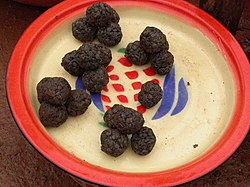Thiéboudiène Boukhonk with tamarind
Autor:
Přisuzování:
Obrázek je označen jako „Vyžadováno uvedení zdroje“ (Attribution Required), ale nebyly uvedeny žádné informace o přiřazení. Při použití šablony MediaWiki pro licence CC-BY byl pravděpodobně parametr atribuce vynechán. Autoři zde mohou najít příklad pro správné použití šablon.
Shortlink:
Zdroj:
Formát:
773 x 733 Pixel (362142 Bytes)
Popis:
A popular variation of Thiéboudiène or ceebu jen, a traditional rice pilaf with fish dish;tomato paste provides the red to the rice, typically served with a separate bowl of spicy pepper and tamarind condiment, in a large communal platter, eaten with spoons or by hand. It is customary to garnish the rice with the large pieces of fish and vegetables to display them when serving. In addition to very recognizable common types of fish and vegetables, are the distinctive regional flavorings of African eggplant diakhatou/jaxatu (Solanum aethiopicum) fermented tamarind seed pods(Tamarindus indica), dried green hibiscus leaves, two cubes of salt-cured 'yet' (a salt-water mollusk, Cymbium marmoratum) and two pieces of 'guedj' (salted cured fish chunks). The name Thiéboudiène Boukhonk is from Wolof language, spellings vary: thiéboudiène uses the French alphabet spelling, ceebu jen is the same word using the official Senegalese alphabet spelling. Ceeb means 'rice', ceebu means 'rice with,' jen means fish. Thiéboudiène is also seen as written as two words thiébou diène Names of this popular West African dish vary between languages and countries.
Licence:
Credit:
Vlastní dílo
Relevantní obrázky
Relevantní články
Senegalská kuchyněSenegelská kuchyně byla ovlivněna francouzskou a portugalskou kuchyní. Hojně užívá arašídy, ryby, maso, vejce, hrášek, rýže, kuskus, čočka nebo fazole. .. pokračovat ve čtení









